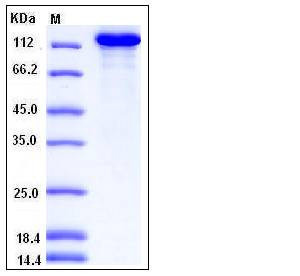Mouse CNTNAP2 / CASPR2 Protein (His Tag)
5430425M22Rik,Caspr2,mKIAA0868
- 100ug (NPP3269) Please inquiry
| Catalog Number | P50649-M08H |
|---|---|
| Organism Species | Mouse |
| Host | Human Cells |
| Synonyms | 5430425M22Rik,Caspr2,mKIAA0868 |
| Molecular Weight | The secreted recombinant mouse CASPR2 comprises 1246 amino acids and has a calculated molecular mass of 139 kDa. The recombinant protein migrates as an approximately 140-150 kDa band in SDS-PAGE under reducing conditions due to glycosylation. |
| predicted N | Ala 28 |
| SDS-PAGE |  |
| Purity | > 95 % as determined by SDS-PAGE |
| Protein Construction | A DNA sequence encoding the extracellular domain of mouse CASPR2 (NP_001004357.2) (Met 1-Ser 1262) was expressed, with a C-terminal polyhistidine tag. |
| Bio-activity | Measured by the ability of the immobilized protein to support the adhesionof C6 Rat brain glial cells . Mouse CASPR2 immobilized (0.8 μg/ml, 100 μl/well) will mediate >30 % C6 cell adhesion. |
| Research Area | Neuroscience |Cell Type Marker in Neurodevelopment |Glial Cell Markers |Oligodendrocyte marker |
| Formulation | Lyophilized from sterile PBS, pH 7.4 1. Normally 5 % - 8 % trehalose and mannitol are added as protectants before lyophilization. Specific concentrations are included in the hardcopy of COA. |
| Background | CNTNAP2/CASPR2 is a member of the neurexin family which functions in the vertebrate nervous system as cell adhesion molecules and receptors. This protein, like other neurexin proteins, contains epidermal growth factor repeats and laminin G domains. In addition, it includes an F5/8 type C domain, discoidin/neuropilin- and fibrinogen-like domains, thrombospondin N-terminal-like domains and a putative PDZ binding site. CNTNAP2/CASPR2 is localized at the juxtaparanodes of myelinated axons, and mediates interactions between neurons and glia during nervous system development and is also involved in localization of potassium channels within differentiating axons. This protein encoding gene is directly bound and regulated by forkhead box protein P2 (FOXP2), a transcription factor related to speech and language development. This gene has been implicated in multiple neurodevelopmental disorders, including Gilles de la Tourette syndrome, schizophrenia, epilepsy, autism, ADHD and mental retardation. CNTNAP2/CASPR2 may play a role in the formation of functional distinct domains critical for saltatory conduction of nerve impulses in myelinated nerve fibers. CNTNAP2/CASPR2 Seems to demarcate the juxtaparanodal region of the axo-glial junction. |
| Reference |
